 [I have tracked the Russian invasion of Ukraine from its beginning last February, updating my input at least once a day. No war in my lifetime, including those directly involving the U.S., has drawn my attention with such force.
[I have tracked the Russian invasion of Ukraine from its beginning last February, updating my input at least once a day. No war in my lifetime, including those directly involving the U.S., has drawn my attention with such force.
I’ll have more to say about that in a future post. As one consequence of this focus, I’ve become fascinated by the sleepwalking submissiveness of the Russian people. More than three decades after the Berlin Wall fell they remain abjectly brainwashed, enough so that they tolerate not only the baldfaced lies of Vladimir Solovyov, Margarita Simonyan, Olga Skabeyeva, and Putin’s other media mouthpieces but even the disappearance into the meatgrinder’s maw of hundreds of thousands of Russian men. I find it astonishing to watch the passivity with which they accept and even embrace their fates.
Which brought to mind the photographs of the Latvian-born Misha Gordin (1946-2020), who emigrated from his Soviet homeland in 1974 and landed in New York City, then moved to Minnesota. I first became aware of his work in the mid-aughts, when I received a commission to prepare an introduction for what would be the first English-language monograph devoted to his work. After several months Gordin, the book’s packagers, and I had agreed on a final version of the text. I received payment for my work. Everything seemed set to go, and then … something happened. I never got the story straight, but from what I gathered some dispute between the book’s publisher, Gordin’s gallerists, and Gordin himself put the project on hold.
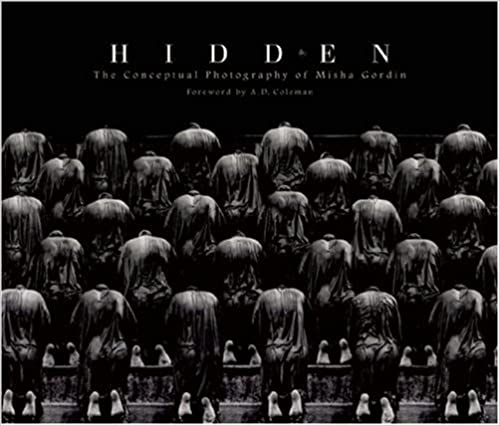
Misha Gordin, Hidden (2008), cover
In October 2008 an outfit called Earth Aware Editions published a 200-page hardcover monograph, Hidden: The Conceptual Photography of Misha Gordin. I’ve never seen a copy, but clearly it exists, listed on Amazon and elsewhere, with an ISBN: 9781933784205. You can actually download a PDF file of it here, and elsewhere on the internet, but those downloads include only the images, and none of the front matter — not even the title and copyright pages.(According to a website dedicated to Gordin’s work, “The book was scheduled to be printed in Hong Kong in [the] summer of 2007 but was ban[ned] from publishing by communist authorities of China.”)
Gordin’s website indicates that in 2007 one Dmitro Voscolov was working on the foreword for this volume. However, though the publisher has neither a copy of the printed book nor a digital version thereof in its files, their records indicate that I provided the foreword. Perhaps some reader with access to a copy can clarify whether the first publication of my text in any form appears below or, instead, this is simply its first appearance online.
Gordin and I never met in person. Because I found unclear the snippets of information about his process available at the time, I sent him a request for details. I’ve appended his responses, also published here for the first time. For biographical information about Gordin, see this 2005 interview at the website dedicated to his work, where you’ll also find an extensive selection of his images. There’s a thoughtful artist’s statement here.— A.D.C.]
•
Reflex of Freedom:
Misha Gordin’s “Imaginary Realities”
Misha Gordin is at one and the same time a fictioneer, a cultural historian, and a prophet.
The imagined world in which Gordin’s extraordinary photographs immerse us seems both entirely alien and eerily familiar: a hermetically sealed system in which constraint and conformity ― perhaps enforced, possibly self-imposed ― prevails. Its ropes, chains, nets, unidentifiable yet onerous burdens, cryptic Sisyphean tasks, furtive inhabitants, and featureless architecture immediately evoke the regulated behavior of twentieth-century Europe’s claustrophobic dictatorships: the former Soviet Union with its satellites, including the Latvia from which Gordin emigrated in the mid-1970s. Yet this world has a distinctly futuristic quality as well, as if offering glimpses of life on another planet in some parallel universe.
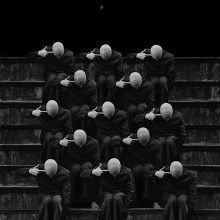
Misha Gordin, Crowd #24, 1990
While this microcosm appears determinedly anti-sensual, consistently gray and somehow granular, the absence of color seems less an aesthetic choice on the artist’s part than a social fact. Though Gordin’s prints are deeply sensuous ― luminous, burnished, tonally rich ― something in them evokes light filtered through a haze of pollution and a perpetual layer of industrial grime. The repetitive, synchronized behaviors enacted by his often masked or otherwise faceless cast of characters echo the police states of the past century, with their devotion to social order as exemplified by the regulated, carefully programmed behavior of masses of people.
What have we here? An analogue for the not-so-distant totalitarian past of some countries, or for the manifestations of that same tendency in the present? A premonition of some post-apocalyptic civilization? It hardly matters. Any informed world citizen knows exactly what Gordin’s symbology represents, regardless of where we position his visions in time and space. Wherever they may be located geopolitically, these humans live beneath the leaden light of a consistently sullen sky, inhabiting a melancholy planet that’s desolate even when crowded.
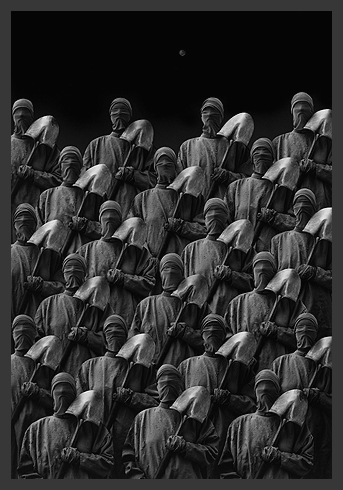
Misha Gordin, Crowd
Yet this evidence does not lack for ambiguity. Such coordinated, rehearsed actions have their positive and voluntary counterparts as well, playing integral parts in parades, dance, martial arts, athletic events, and countless ceremonies. Coordinated group behavior clearly has its appeal, and its unquestionable energy, as anyone who has ever participated in the “human wave” in a stadium will attest. Not surprisingly, then, even within this hive-like culture we can see hints of something other than passive obedience gestating. A face uplifts itself from the herd, a pair of eyes meets our own, a mouth readies itself to speak ― individuality asserting itself against the odds.
And the groups, too, seem inclined to push beyond the limits of their discipline. Behind their backs, one cluster of figures hold keys; another handful have armed themselves with knives, while a dozen young stalwarts with sledgehammers lurk behind concrete buttresses. If the only evidence of creative expression in this hypothetical milieu comes in the form of a mannequin conducting a harp-playing second mannequin on a bleak beach under a looming, ominous sky, then an image depicting pregnancy and another including a newborn child point toward a potentially positive future.
Gordin refers to his approach as “conceptual photography,” though by this he obviously means something much different from the haphazardly made, often amateurish or deliberately casual imagery generated as documentation of performances by conceptual artists since the 1970s.[1] Carefully planned and meticulously crafted, Gordin’s images are previsualized as sketches on paper, which he then stages for the production of the negatives necessary to actualize the imagined image.
•
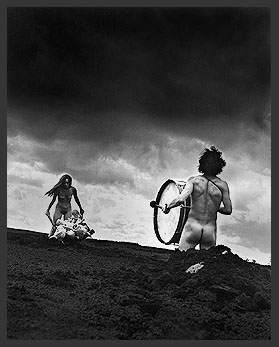
Misha Gordin, Confession (1972)
Gordin considers his 1972 photograph “Confession” to be the jumping-off point for all his future activity in the medium. A staged image involving two nude performers and various props in an outdoor setting, this work resembles nothing then current in eastern European photography. Its orchestrated tableau relates most obviously to the directorial work that had begun to appear in the west from such photographers as Les Krims, Duane Michals, Arthur Tress, Richard Kirstel, and others. But that work ― controversial even in the west at the time[2] ― had not circulated widely in the U.S. by 1972, much less in Europe. Surely few in the eastern bloc knew of it. Gordin’s use of this strategy for those early pieces seems thus a matter of simultaneous invention rather than imitation or influence.
The forms of photocollage and photomontage to which he subsequently gravitated, and which he combined with his directorial tendency, had also begun to experience a resurgence in the ’70s, achieving increased acceptance as central rather than marginal modes of photographic image-making. A younger generation of photographers, spearheaded by such figures as Jerry Uelsmann, Bea Nettles, and Allen A. Dutton moved these forms from the periphery of the medium to its mainstream, in the process drawing renewed attention to older pioneers in both forms such as Edmund Teske, Clarence John Laughlin, John Heartfield, and Hannah Höch.
Such work had a long history in the medium, particularly in Europe (including eastern Europe), where the Dadaists and Surrealists had embraced these approaches in the early decades of the 20th century, making them well-respected as alternative methods of photographic practice. While young artists in the west and other non-totalitarian countries would have seen examples thereof as a matter of course, socialist realism predominated in the USSR and even reproductions of contemporary art from outside the Soviet Union did not circulate widely. Gordin, moreover, had no formal art education; aside from some instruction from a “well-known portrait and documentary photographer,” he is self-taught.
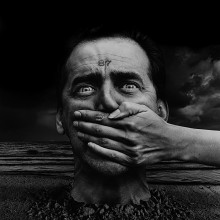
Misha Gordin, Shout #7 (1985)
Despite that, or perhaps because of it, after leaving his native land he devised an extremely idiosyncratic approach to the generation of his images and prints, a methodology that falls somewhere between photomontage and photocollage. These are very different as image-making techniques, divergent in both the operations involved in production and in the look and feel of the resulting works. Our recognition of these differences, and our understanding of the distinctions between them, has not benefited from the misleading use of the term photomontage to cover all variations of both methods.[3]
In photomontage, a darkroom process, one negative gets printed on top of, within, or alongside another on a single sheet of light-sensitive paper. This yields a single, unified print in which, seemingly impossibly, two or more moments in time and space coexist. (An alternative method involves making multiple exposures on a single negative prior to development.) Jerry Uelsmann, Edmund Teske, and Eikoh Hosoe exemplify this practice. With photocollage, two or more photographic prints ― or reproductions of photographs ― get cut and pasted together, or otherwise joined physically on the same surface. John Heartfield,[4] Hannah Höch, Toyen, and Romare Bearden, among others, have employed versions of this method. The combining of these fragments usually results in visible seams or detectable variations among the collage components, especially when one encounters the original collage in its physical form.
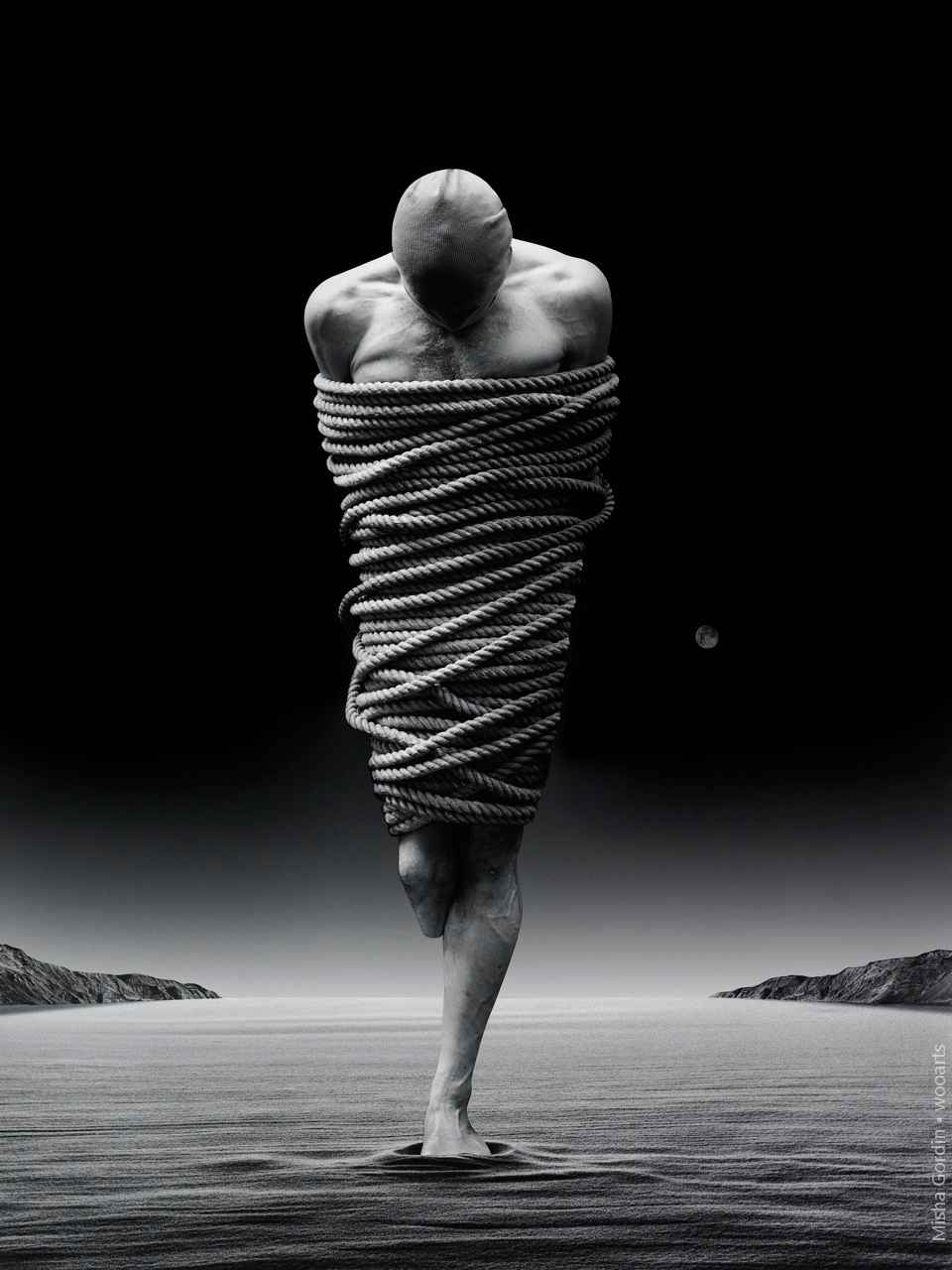
Misha Gordin, Doubt #6
Gordin, as mentioned, operates between these two poles. “I employ both techniques: photocollage in the early stage, to create the composition of the future image, then photomontage for the actual printing of this composition,” the photographer writes. Most of those who employ either photomontage or photocollage build the images up from an archive of negatives or else from a file of fragments of photographic prints and clippings from newspapers and magazines. Gordin, instead, makes individual negatives for each element of the image and collages them together, making what he calls a “negative map,” later printing them one at a time via calibrated exposure to form a seamless, integral whole.[5]
All of that Gordin could surely accomplish more easily by adopting digital means, but he persists on utilizing an analog approach, indicating that only if and when the labor-intensive demands of his present technique exceed his physical capacity will he consider changing over. In addition to his love for the material qualities of the finely crafted gelatin-silver print, and his enjoyment of the distinctive process of facture that he has evolved, he believes that some useful trace of the “truthfulness” of the photographic image persists in his work (despite its staged origins and quilted compilation), a trace that computerized production would diminish or erase.
•
Gordin cites film (especially such directors as Andrey Tarkovsky, Sergei Parajanov, and Lars von Trier) and the Japanese Butoh dance/performance art form as resonant for him. Certainly one can understand his attraction to Butoh, with its emphasis on a frozen moment, a highlighted instant, wrenched, almost brutally, from the flux.[6] He has also named the writers Fyodor Dostoevsky and Mikhail Bulgakov as elective affinities, and has indicated an appetite for classical music.
None of that really explains the work, though a consistent gravitas links them all. Gordin’s purpose is clearly cautionary, his worldview somber if not pessimistic. The questions implicit in his work could not get asked at a more opportune historical moment.
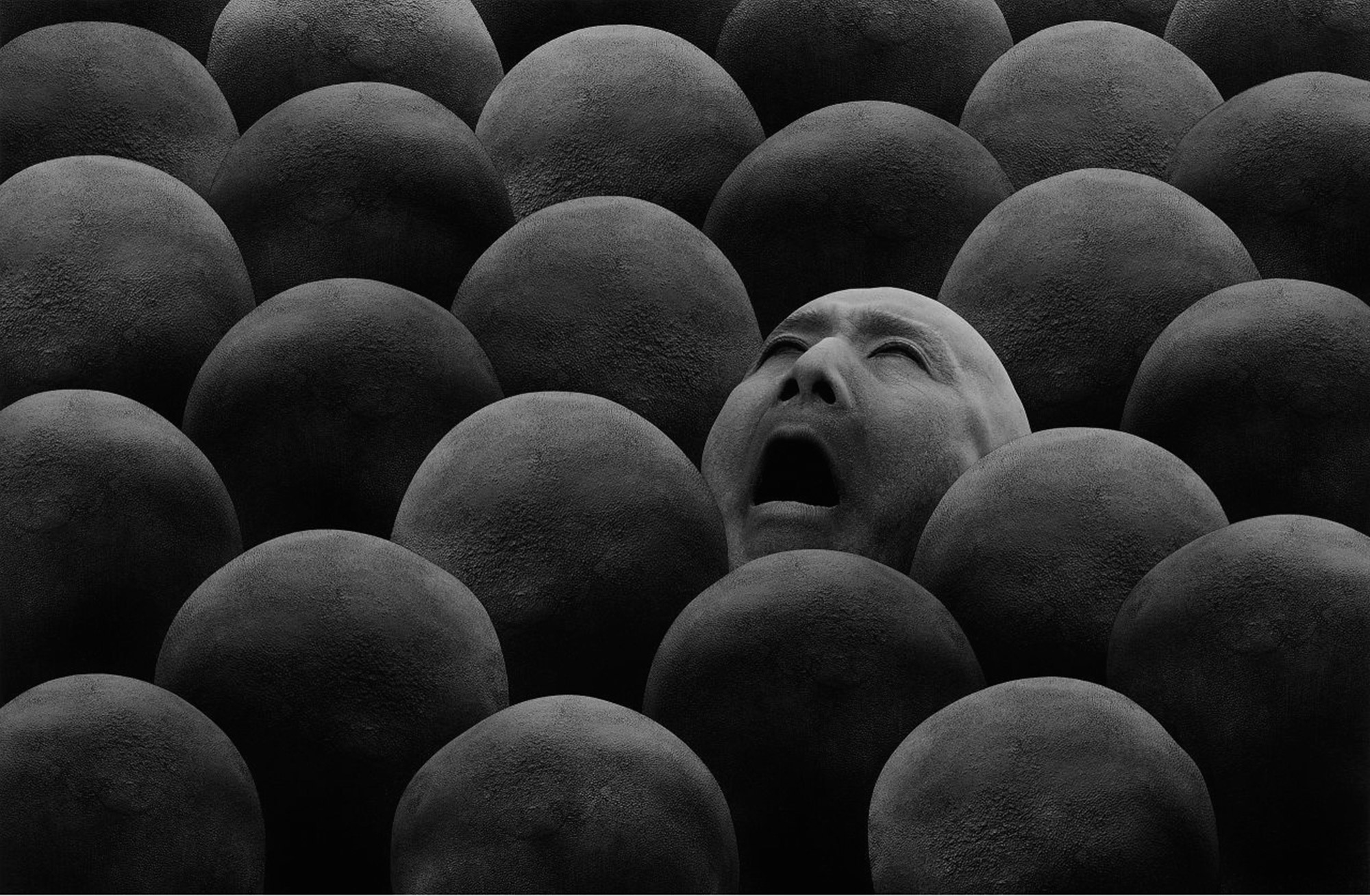
Misha Gordin, Crowd #9
•
The Russian behavioral scientist Ivan Petrovich Pavlov, celebrated for his investigation of the conditioned reflex, noted that in some percentage of his canine subjects the conditioning didn’t take, subverted by an insistent “reflex of freedom.” Presumably that reflex can become genetically recessive, could even get bred out of the species. If achieved, that result in human evolution might look very much like the one frequently postulated in Gordin’s work. Yet the photographer offers us evidence of that “reflex of freedom” beginning to manifest itself, persisting stubbornly enough to give rise to hope, as defined by the Czech playwright and statesman Václav Havel:
“Either we have hope within us or we don’t; it is a dimension of the soul, and it’s not essentially dependent on some particular observation of the world or estimate of the situation. Hope is not prognostication. It is an orientation of the spirit, an orientation of the heart. … It is not the conviction that something will turn out well, but the certainty that something makes sense, regardless of how it turns out.”[7]
Gordin calls these visions of his “imaginary realities.” He leaves it to the viewer to decide how they will turn out. Notably, he offers us the option of hope. From the evidence he provides, it could go either way.
This makes the exercising of your own reflex of freedom all the more urgent, lest you wake up one morning to find that you cannot tell the worst of Misha Gordin’s imaginary realities from your own.
•
Notes
[1] See the essay, “Collaborations Through the Lens: Photography and Performance Art,” in my book Tarnished Silver: After the Photo Boom (New York: Midmarch Arts Press, 1996), pp. 161-65.
[2] Though widely employed in fashion, advertising, and editorial work, the directorial mode had not yet achieved acceptance in the fine-art realm. See the essay “The Directorial Mode: Notes Toward A Definition” in my book Light Readings: A Photography Critic’s Writings, 1968-1978 (Albuquerque: University of New Mexico Press, 1998, second edition), pp. 246-57.
[3] See the essay “Mutant Media: Photo/Montage/Collage” in my book Depth of Field: Essays on Photography, Mass Media and Lens Culture (University of New Mexico Press, 1998), pp. 63-80.
[4] Though what he practiced was photocollage, Heartfield called his process photomontage, and referred to himself as a photomonteur, which has contributed notably to the confusion over the two forms.
[5] Gordin explains his process fully in a note elsewhere in this volume. [See below.]
[6] He has used the Butoh company Sankai Juku as models in several pieces.
[7] Václav Havel, Disturbing the Peace: A Conversation with Karel Hvizdala (New York: Alfred A. Knopf, 1990), p. 181. English translation by Paul Wilson.
•
Mischa Gordin on his Creative Process
I employ both techniques: photocollage in the early stage, to create the composition of the future image, then photomontage for the actual printing of this composition. All my images are assembled in a traditional darkroom under one enlarger using a masking technique developed and perfected over the years.
The process is as follows. First I select, print, and cut out the components of the future image (these are usually the human figures). Then I place these figures on top of the background (if any), adjusting the right proportions and perspective. I’ll spend a week cutting negatives and collaging them together. The figures are repositioned in relation to each other and the surrounding space many times; every variant position is recorded by a large-format camera. From this multitude of reproductions I select the one that appeals to me the most. I call this negative a “map.” That ends the photocollage stage.
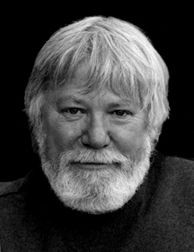
Misha Gordin (2006). Photographer unknown.
Then that “map” negative is projected and precisely outlined on a masking material attached to my printing easel. This enables me to outline sections to be later cut and removed, exposing the light-sensitive material to one specific negative at a time, then reinstalled in their original position after each exposure is complete. (Before I print the first original, I make tests and adjustments for every negative to be printed. I write out tables where I indicate the proper exposure and all sequences of manipulations for every negative used.)
This process is repeated many times, until all the selected negative fragments have been printed and all the surface of the photographic paper has been exposed. One mistake and a lot of work gets wasted. It’s a long process: each photo takes me about a month to do (from the first test shot to the final print), and because of that I only make about six photos a year.
It’s a method of chance, in the early stage. When I print such a group for the first time, I’m not sure what’s going to happen, what it’s going to look like. The stage of printing, on the other hand, is unforgiving. I meticulously project one negative after another, constantly changing precise masks until the last negative is used. It feels like returning safely home after a long, long drive.
•

Special offer: If you want me to either continue pursuing a particular subject or give you a break and (for one post) write on a topic — my choice — other than the current main story, make a donation of $50 via the PayPal widget below, indicating your preference in a note accompanying your donation. I’ll credit you as that new post’s sponsor, and link to a website of your choosing.
And, as a bonus, I’ll send you a signed copy of my new book, poetic license / poetic justice — published under my full name, Allan Douglass Coleman, which I use for my creative writing.






Leave a Comment